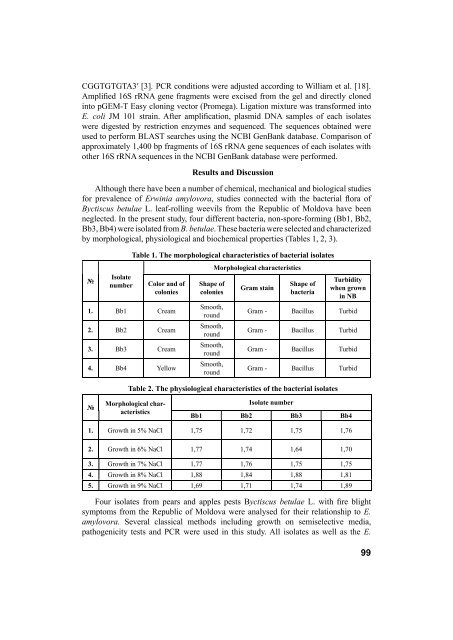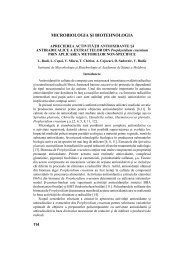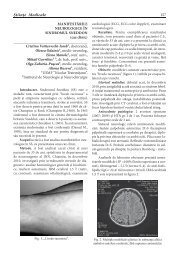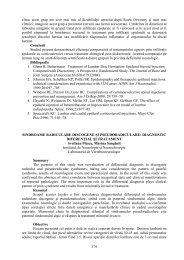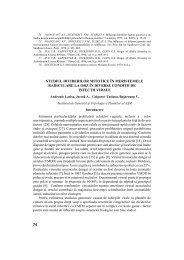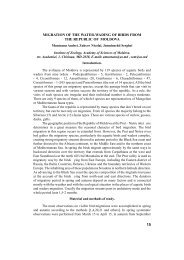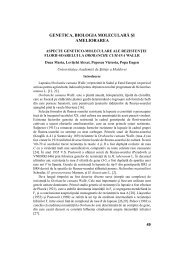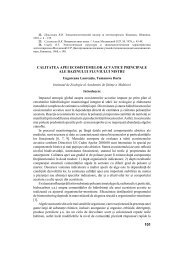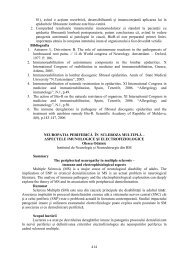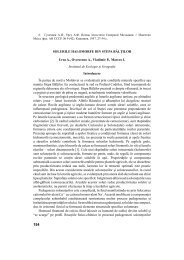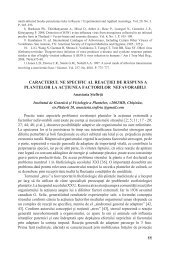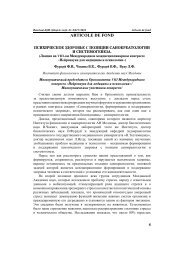198 CUPRINS
198 CUPRINS
198 CUPRINS
You also want an ePaper? Increase the reach of your titles
YUMPU automatically turns print PDFs into web optimized ePapers that Google loves.
CGGTGTGTA3′ [3]. PCR conditions were adjusted according to William et al. [18].<br />
Ampli ed 16S rRNA gene fragments were excised from the gel and directly cloned<br />
into pGEM-T Easy cloning vector (Promega). Ligation mixture was transformed into<br />
E. coli JM 101 strain. After ampli cation, plasmid DNA samples of each isolates<br />
were digested by restriction enzymes and sequenced. The sequences obtained were<br />
used to perform BLAST searches using the NCBI GenBank database. Comparison of<br />
approximately 1,400 bp fragments of 16S rRNA gene sequences of each isolates with<br />
other 16S rRNA sequences in the NCBI GenBank database were performed.<br />
Results and Discussion<br />
Although there have been a number of chemical, mechanical and biological studies<br />
for prevalence of Erwinia amylovora, studies connected with the bacterial ora of<br />
Byctiscus betulae L. leaf-rolling weevils from the Republic of Moldova have been<br />
neglected. In the present study, four different bacteria, non-spore-forming (Bb1, Bb2,<br />
Bb3, Bb4) were isolated from B. betulae. These bacteria were selected and characterized<br />
by morphological, physiological and biochemical properties (Tables 1, 2, 3).<br />
№<br />
Isolate<br />
number<br />
Table 1. The morphological characteristics of bacterial isolates<br />
Color and of<br />
colonies<br />
1. Bb1 Cream<br />
2. Bb2 Cream<br />
3. Bb3 Cream<br />
4. Bb4 Yellow<br />
№<br />
Shape of<br />
colonies<br />
Smooth,<br />
round<br />
Smooth,<br />
round<br />
Smooth,<br />
round<br />
Smooth,<br />
round<br />
Morphological characteristics<br />
Gram stain<br />
Shape of<br />
bacteria<br />
Turbidity<br />
when grown<br />
in NB<br />
Gram - Bacillus Turbid<br />
Gram - Bacillus Turbid<br />
Gram - Bacillus Turbid<br />
Gram - Bacillus Turbid<br />
Table 2. The physiological characteristics of the bacterial isolates<br />
Morphological characteristics<br />
Isolate number<br />
Bb1 Bb2 Bb3 Bb4<br />
1. Growth in 5% NaCl 1,75 1,72 1,75 1,76<br />
2. Growth in 6% NaCl 1,77 1,74 1,64 1,70<br />
3. Growth in 7% NaCl 1,77 1,76 1,75 1,75<br />
4. Growth in 8% NaCl 1,88 1,84 1,88 1,81<br />
5. Growth in 9% NaCl 1,69 1,71 1,74 1,89<br />
Four isolates from pears and apples pests Byctiscus betulae L. with re blight<br />
symptoms from the Republic of Moldova were analysed for their relationship to E.<br />
amylovora. Several classical methods including growth on semiselective media,<br />
pathogenicity tests and PCR were used in this study. All isolates as well as the E.<br />
99


